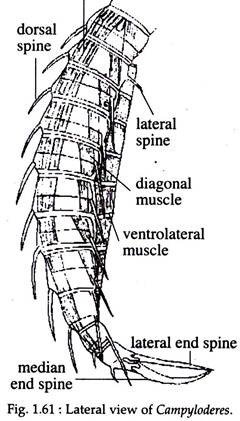In this article we will discuss about the Phylum Kinorhyncha:- 1. Introduction to Phylum Kinorhyncha 2. Diagnostic Features of Phylum Kinorhyncha 3. Scheme of Classification.
Introduction to Phylum Kinorhyncha:
The phylum Kinorhyncha, formerly known as Echinodera or Echinoderida, were recognized in 1851. They are commonly known as mud-dragons and are minute, interstitial, deposit-feeding aschelminths that occur in soft sediments and equivalent cryptic marine microhabitats.
They have been found in the intertidal zone to depths of several thousand metres. They are often confused with copepod crustaceans, but differ mainly in the absence of paired appendages.
Etymology:
ADVERTISEMENTS:
Greek: kinema, motion; rynchos, snout.
Diagnostic Features of Phylum Kinorhyncha:
i. Body short (less than 1 mm in length), grub-like and bilaterally symmetrical.
ii. Body more than two cell layer thick, with tissues and organs.
iii. Epidermis with a spiny chitinous cuticle that divides into segments (zonites) and each zonite comprises of a single dorsal and paired ventral plates.
ADVERTISEMENTS:
iv. Body wall has circular and diagonal muscles.
v. Body divided into head, neck and trunk. Head comprises the first segment, neck makes up the second and the trunk in all adult contains 11 segments.
vi. Body cavity is a fluid-filled pseudocoel that is reduced and may be absent entirely in many species.
vii. Mouth is at the end of a spiny, anterior, retractile head. The rest part of the alimentary system is tubular with a muscular pharynx and a posterior anus.
ADVERTISEMENTS:
viii. Excretory system consists of two protonephridia that open to the lateral surface of the 11th segment. Solenocytes with paired cilia and multiple nuclei.
ix. The nervous system which is present within the epidermis, comprises of a ganglionated nerve ring around the anterior part of pharynx and extending from it a mid-ventral nerve cord with paired ganglia in each segment.
x. Kinorhynchs are dioecious, development is direct and moulting occurs with growth.
Scheme of Classification of Phylum Kinorhyncha:
The phylum Kinorhyncha consists of a small group of about 150 described marine animals that have been divided into two orders — Cyclorhagida and Homalorhagida. Like that in the gastrotricha, the above two orders should have been elevated to class category after the up-categorization of class Kinorhyncha (previously under phylum Aschelminthes) to phylum status.
Although, still designated as orders each category actually holds class rank (Ruppert and Barnes, 1994).
The order (class) Cyclorhagida has 14 to 16 closing plates in the neck region of most species. Their trunk is spiny and circular to triangular in cross section. They are most widely distributed and common in marine muds and sub-tidal sands.
Example:
Echinoderes, Campyloderes (Fig. 1.61).
The order (class) Homalorhagida has 6 to 8 closing plates in the neck region. Their trunk is with few spines and distinctly triangular in cross section. They are relatively dorsolateral muscle large (up to 1 mm) and are common in marine muds.
ADVERTISEMENTS:
Example: Pycnophyes.
